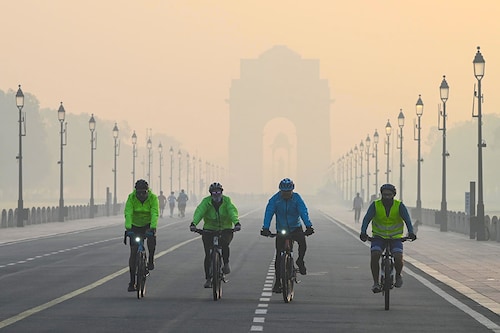The (dangerous) air India breathes
According to the World Air Quality Report released recently for 2023, the 100 worst-polluted cities in the world are in Asia—83 of which are in India


India is the third-most polluted country in the world after Bangladesh and Pakistan. What is more alarming is the fact that the country is home to 83 of the world’s 100 most-polluted cities, as per the sixth annual World Air Quality Report. The report highlights that Begusarai in Bihar was the most-polluted metropolitan area of 2023, and India was home to the four most-polluted cities in the world last year—the others being Guwahati, Assam Delhi and Mullanpur, Punjab.
Air pollution, considered the most significant environmental peril to human well-being, is the reason behind one out of every nine global fatalities, approximately. The World Health Organization (WHO) reports an alarming seven million premature deaths annually attributable to air pollution. The report looked specifically at fine particulate matter, or PM2.5, which is the tiniest pollutant but also the most dangerous. Exposure to PM2.5 pollution not only triggers and worsens various health ailments like asthma, cancer, stroke and lung disease but also hampers children"s cognitive growth, contributes to mental health challenges, and complicates pre-existing conditions such as diabetes. As per the report, only 9 percent of more than 7,800 cities analysed globally recorded air quality that met WHO’s standard, which says average annual levels of PM2.5 should not exceed 5 micrograms per cubic metre.
Also watch: Inhaling air pollution can increase risk of diabetes: Explained
The report highlights that 124 (92.5 percent) of 134 countries and regions exceeded the WHO annual PM2.5 guideline value. Only seven countries—Australia, Estonia, Finland, Grenada, Iceland, Mauritius and New Zealand—met the WHO annual PM2.5 guideline (annual average of 5 µg/m3 or less).
The findings of the 2023 World Air Quality Report are based on the compiled PM2.5 air quality information from 7,812 cities across 134 countries, regions and territories, with data gathered from over 30,000 air quality monitoring stations operated by various entities, including research institutions, governmental agencies, universities, non-profit organisations, private enterprises and citizen scientists.
Earlier this week, the World Meteorological Organization (WMO), the weather agency of the United Nations, issued a "red alert" concerning global warming. This comes as it highlights unprecedented rises in greenhouse gases, land and water temperatures, and the rapid melting of glaciers and sea ice over the past year. In its report released on Tuesday, the WMO expressed a "high probability" that 2024 will mark another record-hot year, emphasising that global efforts to counteract this trend have fallen short.
As per the World Air Quality report, the human-caused climate crisis, driven by the burning of fossil fuels, plays a “pivotal" role in influencing air pollution levels, and that climate change will only make pollution worse as extreme heat becomes more severe and frequent. While the report suggests that much more work remains to be done to combat air pollution, on a positive note, it believes that addressing the goal to lessen air pollution and climate change is feasible, offering opportunities for comprehensive environmental improvements.
First Published: Mar 21, 2024, 13:40
Subscribe Now